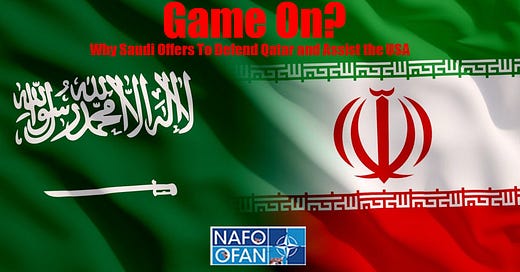Saudi Arabia v Iran - Game On?
A brief explainer on why Saudi has come to Qatars defence and also tacitly supports the USA’s attack on Iran.
A brief explainer - why Saudi has supported Qatar and the USA in the conflict with Iran. A shallow dive by Beefy to give you some context around this unlikely alliance.
As Iran fired back at the U.S. on June 23rd, 2025 - with a strike on the American Al Udeid Air Base in Qatar, in what is already being seen as merely a face-saving gesture. Qatar said it had intercepted the Iranian missiles and condemned the attack, calling it a violation of its sovereignty.
But even as Middle Eastern leaders were quick to criticise President Donald Trump’s paradigm-shifting assault on Iran following 10 days of Israeli bombardment, the American strikes are likely to be accepted — and even privately cheered — by an Arab officialdom that has long seen Shia Iran as the primary threat to regional stability.
“These countries are quietly delighted to see Iran cut down to size,” said Firas Maksad, the managing director for the Middle East and North Africa at the Eurasia Group. “But the primary objective is to guard against blowback targeting them.”
Saudi Arabia, Qatar and Kuwait have distanced themselves from the US:
Back in April 2025, Saudi Arabia, Qatar, and Kuwait secretly told Tehran that they will not allow the US to use their air bases to strike Iran. Saudi Arabia and Kuwait told the Iranians that barring the Americans includes supporting operations, such as allowing US refuelling or reconnaissance aircraft to participate in any missions supporting such an attack.
Monday 23 June, 2025: Saudi Arabia is ready to support Qatar in all possible ways in its response to Iran's strikes. What lies behind this mission creep of support?
Why is Saudi now supporting other countries against Iran?
The decades-old feud between them is exacerbated by religious differences. They each follow one of the two main branches of Islam - Iran is largely Shia Muslim, while Saudi Arabia sees itself as the leading Sunni Muslim power.
The primary ideological difference between Saudi Arabia and Iran lies in their interpretations of Islam and its role in governance.
While religious differences are a significant factor, the rivalry between Saudi Arabia and Iran is also a power struggle for regional dominance. Both countries have been involved in proxy conflicts across the Middle East, supporting different sides in wars and conflicts.
Both nations compete for economic and political influence in the region, with Saudi Arabia emphasising its economic power and Iran emphasising its revolutionary ideology.
Saudi Arabia, a Sunni monarchy, adheres to Wahhabism, a strict interpretation of Sunni Islam, and positions itself as the guardian of Islam's holiest sites. Historically, Saudi Arabia has expressed anti-Shia sentiment, viewing Shia Islam as heretical, and this influences its foreign policy.
Iran, on the other hand, is a Shia theocracy, combining elements of clerical rule with a presidential system. This religious divide fuels their rivalry and shapes their foreign policy. Iran has historically supported Shia groups and movements in other countries, which has led to tensions with Saudi Arabia and other Sunni-dominated nations.
This religious schism is reflected in the wider map of the Middle East, where other countries have Shia or Sunni majorities, some of whom look towards Iran or Saudi Arabia for support or guidance.
Saudi/USA Oil Game:
Israel’s sudden attack on Iran has threatened to disrupt oil supplies in the Middle East, placing the Opec+ cartel’s recent decision to increase crude production into the spotlight.
The Saudi Arabia-led producer group has surprised the oil market this year by fast-tracking the return of idled production even as crude prices fell. It has prompted speculation that the cartel was responding to White House pressure to boost output ahead of a confrontation with Iran.
The Saudi’s have therefore worked in concert with the USA to prevent a spike in oil prices as the conflict with Iran has gathered pace.
The FT reported that officials in Riyadh were well aware that pumping more oil would have pleased Trump, who in January said he would ask Saudi Arabia and Opec to “bring down the cost of oil”.
But analysts and traders say the producers had their own reasons to begin unwinding production cuts, independent of geopolitical events.
After holding back supply for almost three years to push prices higher, the output curbs were no longer having as much impact, said analysts. It made sense to begin restoring output in the hope of retaking market share.
Several Opec+ members — notably Kazakhstan — had been pumping above their quota. That was frustrating Saudi Arabia, the group’s biggest exporter and de facto leader. It had shouldered the majority of the curbs, reducing its own output by as much as 2million barrels a day — about 2 per cent of total world supply.
Trump has almost certainly asked the Saudis to pump even more oil, although this would raise difficult questions for Riyadh. Iran is one of the original members of Opec and the kingdom will be wary of disrupting a détente between Iran and its Arab neighbours in the Gulf
References and sources:
https://www.tehrantimes.com/news/511319/S-Arabia-UAE-and-Kuwait-refuse-to-let-US-use-air-bases-for
https://www.bbc.com/news/world-middle-east-42008809
https://www.nbcnews.com/world/middle-east/us-strikes-iran-arab-leaders-support-rcna214442







